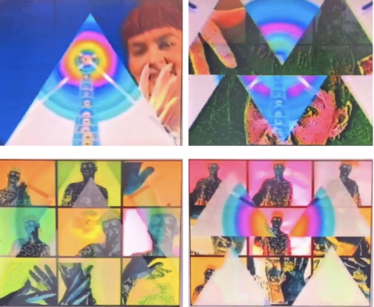Megan Phipps - Folded Distances, Techno-Rhythm, and Networked Aesthetics
The techno-aesthetic experience of the networked rave is a dialectic of intimacy and distance, a dance of spatial and rhythmic dynamics oscillating between proximity and separation, individuality and collectivity, orientation and disorientation. The foggy dancefloor, saturated with recursive rhythms and stroboscopic flickers, embodies a rhythmic space[1]: a site where collective resonance dissolves rigid spatial boundaries, while reasserting the interplay of center and periphery. Distance is not erased but folded, stretched, and reframed within industrial-mechanical recursive cycles of decentralised visuals, sound, light, and (collective) movement. These recursive oscillations serve as both structuring force and site of disjunction—a deterritorialized zone of molecular motion where identity, agency, and perception are rendered and recalibrated. The techno-aesthetic event, like Germany’s Tekknozoid (Fig. 1) or Dreamscape (Fig. 2), transforms physical space into rhythmic space. The techno surround-sound[2] is both liberating and oppressive: it promises escape from surveillance, capitalist time, and social judgment, while simultaneously demanding submission to its mechanical recursion.


In techno-events, virtual augmentation reconstructs proximity through rhythmic entrainment, transforming collective movement into shared sensory experiences—a distributed intimacy mediated by rhythm and audiovisual affect.[3][4][5][6][7][8][9] Distance simultaneously manifests as resonant intervals—liminal suspensions of flickering beats, fragmented gestures, and remixed imagery. Layered visuals, sonic synchronicities and recursive oscillations evoke a liminal Fold,[10] compressed in density and entangled across time and space. Teetering between proprioception and vertigo, these folded distances exemplify “network anesthesia”,[11] where rhythmic ecstasy and numbing simultaneity converge. This network-disorientation functions as both a “technique of ecstasy” and a numbing simultaneity of nodes, links, and flows that obscure relationalities from the local to the global.
Experimental filmmaker and VJ Peter Rubin captures these dynamics in split-screen panels and rapid rhythmic alternations.[12] His projections, such as Mayday VisionMix 1 (1992) (Fig. 3), anticipated today’s techno-aesthetics: hypermodulated, synthetic visuals traversing a "sea of data"[13]—a corpuscular media-ecological fog[14][15] of networked bombardment. This lineage extends toward contemporary techno-images that float within vast networked assemblages: slippery, sticky,[16][11] "groundless"[17] configurations layered within rendered ambiguity and buffered abstraction.

Rhythm extends beyond the temporal patterns of a techno beat and into pulses[18] of bio-technical systems of internal/external resonance, mediating the interaction between organic and machinic domains[19] through “technoecologies of sensation”[20] of tranductive interaction. Synchronization between organic movement and machinic processes enhances proximity and control, as seen in apps like Google Maps or Strava. These apps, linking to platforms like Spotify, foster distributed intimacies through rhythmic cycles of asynchronous interaction, blurring the lines between physical and virtual, organic and mechanical.
This political-aesthetic shift marks the transformation from linear input/output models to recursive feedback loops, expanding distances and fostering distributed intimacies. Techno-rhythm mediates the entanglement of proximity and distance, reshaping intimacy, communication, and collective experience in networked environments. Recursive feedback loops and algorithmic flows destabilize fixed sensory frameworks, transforming perception and meaning. This shift in the ontology of trance marks a move from bounded cinematic frames to pervasive networked conditions embedded within folded distances.
The question then remains: where, exactly, are these folded distances leading us towards?
- ↑ Lefebvre, Henri. Rhythmanalysis: space, time, and everyday life. New York: Bloomsbury Academic, 2017.
- ↑ Turner, Fred. (2013). The Democratic Surround: Multimedia and American Liberalism from World War II to the Psychedelic Sixties. Chicago; London: The University of Chicago Press.
- ↑ Butler, Mark J. Unlocking the Groove: Rhythm, Meter, and Musical Design in Electronic Dance Music. Bloomington: Indiana University Press, 2006.
- ↑ Gaillot, Michel. Multiple Meaning Techno: An Artistic and Political Laboratory of the Present. Paris: Editions des Voi, 1999.
- ↑ Garcia, Luis-Manuel. “Feeling the Vibe: Sound, Vibration, and Affective Attunement in Electronic Dance Music Scenes.” Ethnomusicology Forum 29 (1), 2020, p. 21-39.
- ↑ Holl. Ute. Cinema, Trance, & Cybernetics. Amsterdam: Amsterdam University Press, 2017.
- ↑ Reynolds, Simon. Energy Flash: A Journey through Rave Music and Dance Culture. London; Picador: Faber and Faber Incorporated, 1998.
- ↑ St. John, Graham. (2009). Technomad: Global Raving Countercultures. London: Equinox Publishing Ltd.
- ↑ Thorton, Sarah. (1995). Club Cultures: Music, Media and Subcultural Capital. Cambridge: Polity Press.
- ↑ Deleuze, Gilles.The Fold: Leibniz and the Baroque. New York: Continuum, 1988: 2006.
- ↑ 11.0 11.1 Munster, Anna. An Aesthesia of Networks: Conjunctive Experience in Art and Technology. Cambridge, MA: MIT Press, 2013.
- ↑ Deleuze, Gilles. (1983). Cinema 1: The Movement-Image. Bloomsbury Revelations, 2020.
- ↑ Steyerl, Hito. (2016). “A Sea of Data: Apophenia and Pattern (Mis-)Recognition.” e-flux journal: Issue #72. URL: https://www.e-flux.com/journal/72/60480/a-sea-of-data-apophenia-and-pattern-mis-recognition/
- ↑ Massumi, Brian. Parables for the Virtual: Movement, Affect, Sensation. Durham & London: Duke University Press, 2002, p. 146.
- ↑ Gibson, James J., & Waddell, Dickins. “Homogenous Retinal Stimulation and Visual Perception.” American Journal of Psychology 65, no.2, 1952, p. 263-70.
- ↑ Rushkoff, Douglas. (2010). Media Virus!: Hidden Agendas in Popular Culture. Random House Publishing Group.
- ↑ Gil-Fournier, Abelardo & Parikka, Jussi. Living Surfaces: Images, Plants, and Environments of Media. Cambridge; London: The MIT Press, 2024.
- ↑ Cowan, Michael.Technology’s Pulse: Essays in Rhythm in German Modernism. Institute of Germanic and Romance Studies. London: School of Advanced Study, University London, 2012.
- ↑ Simondon, Gilbert. (1989). Du mode d'existence de objets techniques. Paris: Aubier-Flammarion.
- ↑ Parisi, Luciana. “Technologies of Sensation.” Deleuze|Guattari & Ecology eds. Bernd Herzogenrath, 2009, p. 182-200.